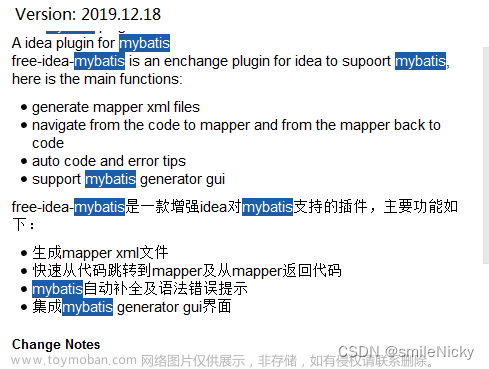MyBatis的自定义插件
前置知识
MyBatis 可以拦截的四大组件
- Executor - 执行器
- StatementHandler - SQL 语句构造器
- ParameterHandler - 参数处理器
- ResultSetHandler - 结果集处理器
自定义 MyBatis 插件
/**
* 打印 sql 执行的时间插件
*/
@Intercepts(
// 指定拦截器拦截的对象、方法和参数类型
{@Signature(type = StatementHandler.class, method = "update", args = {Statement.class}),
@Signature(type = StatementHandler.class, method = "query", args = {Statement.class, ResultHandler.class}),
@Signature(type = StatementHandler.class, method = "batch", args = {Statement.class})}
)
// 注册到 Spring 容器,不是 Spring 环境的话可以用 mybatis 的 config 配置进去
@Component
public class SqlExecuteTimePrintMybatisPlugin implements Interceptor {
protected Logger logger = LoggerFactory.getLogger(SqlExecuteTimePrintMybatisPlugin.class);
@Override
public Object intercept(Invocation invocation) throws Throwable {
// 获取代理对象
StatementHandler statementHandler = (StatementHandler) invocation.getTarget();
// 获取执行 sql
BoundSql boundSql = statementHandler.getBoundSql();
// 此处简单处理一下,只打印参数替换前的 sql,目的是演示自定义插件
String sql = boundSql.getSql();
long start = System.currentTimeMillis();
try {
return invocation.proceed();
} finally {
logger.info("sql -> {}, takes time -> {}", sql, System.currentTimeMillis() - start);
}
}
}
效果如下
2023-10-14 17:18:39.297 INFO 25972 --- [p-nio-80-exec-1] c.y.m.c.SqlExecuteTimePrintMybatisPlugin : sql -> SELECT * FROM `INFO` WHERE `id` = ? , takes time -> 57
2023-10-14 17:18:39.324 INFO 25972 --- [p-nio-80-exec-1] c.y.m.c.SqlExecuteTimePrintMybatisPlugin : sql -> SELECT `id`, `info_id`, `extend_info` FROM `INFO_DETAIL` WHERE `info_id` = ?, takes time -> 4
源码解析
创建四大对象的代码如下
public class Configuration {
public ParameterHandler newParameterHandler(MappedStatement mappedStatement, Object parameterObject, BoundSql boundSql) {
ParameterHandler parameterHandler = mappedStatement.getLang().createParameterHandler(mappedStatement, parameterObject, boundSql);
// 此处增加拦截器责任链
parameterHandler = (ParameterHandler) interceptorChain.pluginAll(parameterHandler);
return parameterHandler;
}
public ResultSetHandler newResultSetHandler(Executor executor, MappedStatement mappedStatement, RowBounds rowBounds, ParameterHandler parameterHandler,ResultHandler resultHandler, BoundSql boundSql) {
ResultSetHandler resultSetHandler = new DefaultResultSetHandler(executor, mappedStatement, parameterHandler, resultHandler, boundSql, rowBounds);
// 此处增加拦截器责任链
resultSetHandler = (ResultSetHandler) interceptorChain.pluginAll(resultSetHandler);
return resultSetHandler;
}
public StatementHandler newStatementHandler(Executor executor, MappedStatement mappedStatement, Object parameterObject, RowBounds rowBounds, ResultHandler resultHandler, BoundSql boundSql) {
StatementHandler statementHandler = new RoutingStatementHandler(executor, mappedStatement, parameterObject, rowBounds, resultHandler, boundSql);
// 此处增加拦截器责任链
statementHandler = (StatementHandler) interceptorChain.pluginAll(statementHandler);
return statementHandler;
}
public Executor newExecutor(Transaction transaction) {
return newExecutor(transaction, defaultExecutorType);
}
public Executor newExecutor(Transaction transaction, ExecutorType executorType) {
executorType = executorType == null ? defaultExecutorType : executorType;
executorType = executorType == null ? ExecutorType.SIMPLE : executorType;
Executor executor;
if (ExecutorType.BATCH == executorType) {
executor = new BatchExecutor(this, transaction);
} else if (ExecutorType.REUSE == executorType) {
executor = new ReuseExecutor(this, transaction);
} else {
executor = new SimpleExecutor(this, transaction);
}
if (cacheEnabled) {
executor = new CachingExecutor(executor);
}
// 此处增加拦截器责任链
executor = (Executor) interceptorChain.pluginAll(executor);
return executor;
}
}
-
首先在创建 Executor、StatementHandler、ParameterHandler、ResultSetHandler 四个对象时,将插件(plugins)注入
-
调用 InterceptorChain.pluginAll() 方法将插件增加到责任链,并返回代理后的 target 包装对象,InterceptorChain 保存了所有的拦截器(Interceptors)
-
最终在执行的时候调用的其实是 JDK 动态代理的对象,执行 MyBatis 中
InvocationHandler的实现org.apache.ibatis.plugin.Plugin的 invoke 方法文章来源:https://www.toymoban.com/news/detail-725281.html
public class InterceptorChain {
private final List<Interceptor> interceptors = new ArrayList<>();
public Object pluginAll(Object target) {
for (Interceptor interceptor : interceptors) {
target = interceptor.plugin(target);
}
return target;
}
}
public interface Interceptor {
// 拦截器增强方法
Object intercept(Invocation invocation) throws Throwable;
// 包装原来的对象
default Object plugin(Object target) {
return Plugin.wrap(target, this);
}
default void setProperties(Properties properties) {
// NOP
}
}
public class Plugin implements InvocationHandler {
private final Object target;
private final Interceptor interceptor;
private final Map<Class<?>, Set<Method>> signatureMap;
private Plugin(Object target, Interceptor interceptor, Map<Class<?>, Set<Method>> signatureMap) {
this.target = target;
this.interceptor = interceptor;
this.signatureMap = signatureMap;
}
public static Object wrap(Object target, Interceptor interceptor) {
Map<Class<?>, Set<Method>> signatureMap = getSignatureMap(interceptor);
Class<?> type = target.getClass();
Class<?>[] interfaces = getAllInterfaces(type, signatureMap);
if (interfaces.length > 0) {
// jdk 动态代理
return Proxy.newProxyInstance(
type.getClassLoader(),
interfaces,
new Plugin(target, interceptor, signatureMap));
}
return target;
}
@Override
public Object invoke(Object proxy, Method method, Object[] args) throws Throwable {
try {
// 获取插件中生命要增强的方法
Set<Method> methods = signatureMap.get(method.getDeclaringClass());
// 如果命中该方法,就使用执行插件中增强的方法
if (methods != null && methods.contains(method)) {
return interceptor.intercept(new Invocation(target, method, args));
}
// 没有命中就不对方法进行增强
return method.invoke(target, args);
} catch (Exception e) {
throw ExceptionUtil.unwrapThrowable(e);
}
}
...
}
备注
不明白的需要去看下 JDK 动态代理实现原理,概括的来讲就是
Proxy#newProxyInstance时,通过字节码增强的方法,生成一个实现了跟被代理类相同接口并继承了java.lang.reflect.Proxy的类并返回其实例,调用这个代理类的方法时,实际上调用的是 Proxy.InvocationHandler.invoke(this, method, new Object[]{args}) 方法文章来源地址https://www.toymoban.com/news/detail-725281.html
到了这里,关于MyBatis的自定义插件的文章就介绍完了。如果您还想了解更多内容,请在右上角搜索TOY模板网以前的文章或继续浏览下面的相关文章,希望大家以后多多支持TOY模板网!











